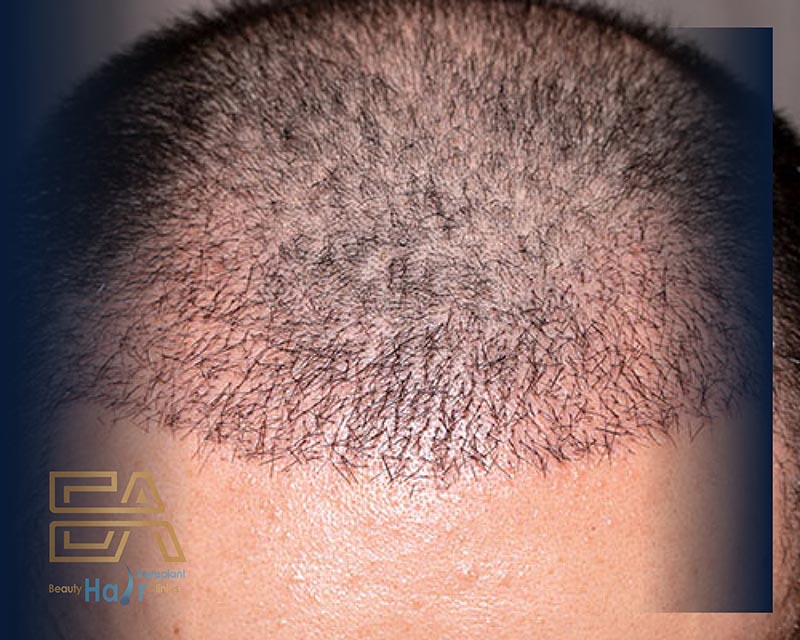Hair Replacement or Hair Transplant
Hair Replacement Or Hair Transplant
Being attractive and feeling confident depend greatly on having healthy hair, which can also influence social interactions. Numerous factors affect the health and thickness of hair, and some of these factors may also be responsible for baldness. According to statistics, one in three people may eventually experience hair loss. Microsurgical hair transplantation is a treatment carried out in an operating room. It is currently regarded as the most efficient and long-lasting treatment for baldness. Turkey, Germany and Some Asian Countries also offer great Services in Hair Transplant Such as India, Afghanistan and Pakistan is a popular destination for people looking for a solution to this issue because of its cutting-edge medical facilities and highly skilled medical staff.
The Causes of Hair Loss
Genetic influences,
• Scalp ailments including ringworm,
• Some chronic conditions;
• Thyroid issues;
• Drug side effects that result in hair loss;
• Metabolic conditions,
• Poor hair care
• Anemia brought on by a lack of iron,
• Neurological and psychological conditions like stress
• An imbalanced diet with few vitamins
• For women, menopause, pregnancy, and postpartum hormones;
Both men and women can lose their hair due to the aforementioned factors. Some of these are transient, while others are long-term. In the natural hair cycle, hair that grows during a specific time is weaning through discoloration. And in this manner, the natural hair cycle continues. Throughout the day, you lose and regrow hair. There are more than 100 hairs that fall out each day, which is normal. However, there are over 100 spills and openings in certain places, which is a sign of a problem. To stop hair loss, numerous different strategies have been explored. However, when used properly, hair transplantation is the most efficient and rewarding option available.
Who Can Have a Hair Transplant Procedure
Baldness may result from male hormone features. Male pattern baldness manifests itself in a variety of ways. Usually, it starts at the top of the scalp or the hairline’s borders. Women may have hair loss as well.
If the patient requires a hair transplant procedure, a skilled hair transplantation expert can assess the kind, ratio, and potential causes of hair loss. If the medical professional so chooses, they will also choose the procedure to be followed throughout the operation. Anyone above the age of 22 may have a hair transplant procedure done.
Prior to undergoing hair transplantation
Aside from genetics, hair loss can also be caused by ringworm on the scalp, some chronic illnesses, thyroid issues, and prescription side effects.
- Metabolic conditions,
- Poor hair care; • Anemia brought on by a lack of iron;
Stress-related psychological and neurological conditions; an imbalanced diet low in vitamins;
- For women, menopause, pregnancy, and postpartum hormones;
Both men and women can lose their hair due to the aforementioned factors. Some of these are transient, while others are long-term. In the natural hair cycle, hair that grows during a specific time is weaning through discoloration. And in this manner, the natural hair cycle continues. Throughout the day, you lose and regrow hair. 100 hair strands are lost on average per day, but if there are more than 100 spills or openings in some places, there may be a problem. To stop hair loss, numerous different strategies have been explored. However, when used properly, hair transplantation is the most efficient and rewarding option available.
Hair Transplantation Techniques
Hair grafts are typically taken one at a time rather than at regular intervals to prevent opening up and dilutions in donor areas during the hair transplant procedure, which is typically done under local anesthetic to prevent pain. The healthy grafts are segregated and put in a designated space in 100 rows after the extraction is finished. The number of grafts needed for transplantation varies based on the area’s width and clarity, as well as the patient’s hair’s thickness and kind. The channels are opened, the grafts are transplanted into them, and the front cut line is determined to ensure the patient’s facial shape and natural appearance after all these treatments are finished., the length of the procedure varies depending on how many transplants are required, but it typically lasts 6 to 10 hours.

New German Red Ruby
For the restoration of natural and growable hair, the German Red Ruby technique is the most applicable and newest technique nowadays.
The New German Red Ruby is the most useful method in 2023 because all the problems of the other techniques are solved by this technique. This method creates canalizations for implantation based on the shape and size of the follicles.
The following are additional benefits of German Red Ruby blades:
Enables denser graft implantation,
Reduced risk of complications,
More natural appearance,
Shorter recovery period.
Turkish Black Diamond
Turkish Black Diamond Method, The Turkish Black Diamond technique is called Sapphire Black Diamond and Sapphire Blue Diamond as well. This method is also used for hair transplantation nowadays, but it’s not as standard as the new German Red Ruby. We serve with this technique as well.
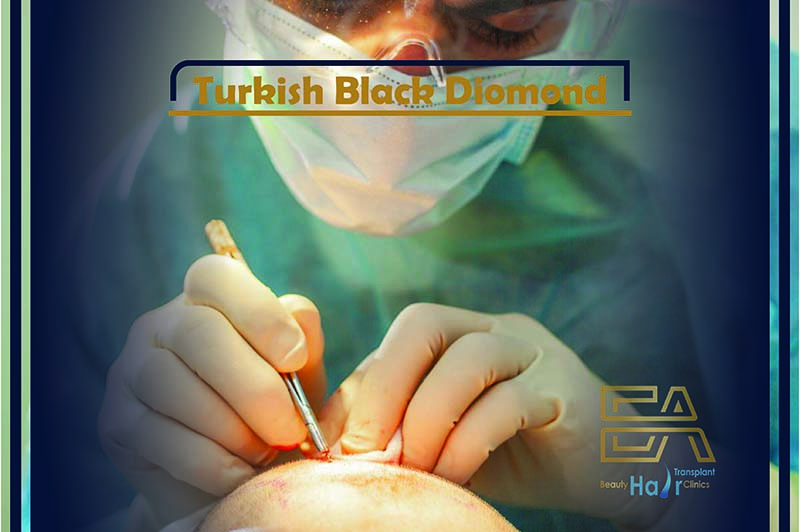

Turkish Sapphire FUE
With the exception of the blade used throughout the operation, Sapphire FUE is essentially the same as the original FUE method. Instead of using a razor or a steel blade, a sapphire blade is utilized in this technique to create channels on the scalp during the transplant.
Follicles are removed and then implanted into the channels that the sapphire blades have opened during the initial stage of hair transplantation. Because it affects the density, angle, and direction of the hair growth, opening the channels is the most crucial step in the hair transplant technique. The sapphire blades’ narrow hole allows the grafts to be replaced without coming into contact with the outside world. We serve with this technique as well.
FUE Technique
FUE Technique is called Classic FUE / Standard FUE/ Turkish FUE as well.
The Follicular Unit Extraction procedure involves taking hair grafts out of the donor area using a specialized tool before implanting them on bald spots. The most cutting-edge procedure is the FUE technique, which has been used since 2006. With this technique, grafts are removed with a special device from the donor area and implanted in channels around 0.7/0.8mm using special inserts. These grafts may contain cells of two or three packs. The number of transplant recipients can be up to 12,000 removed on a 5,000 unit. The root can be taken simultaneously with the grafts using a special device. With no cutting or skin band
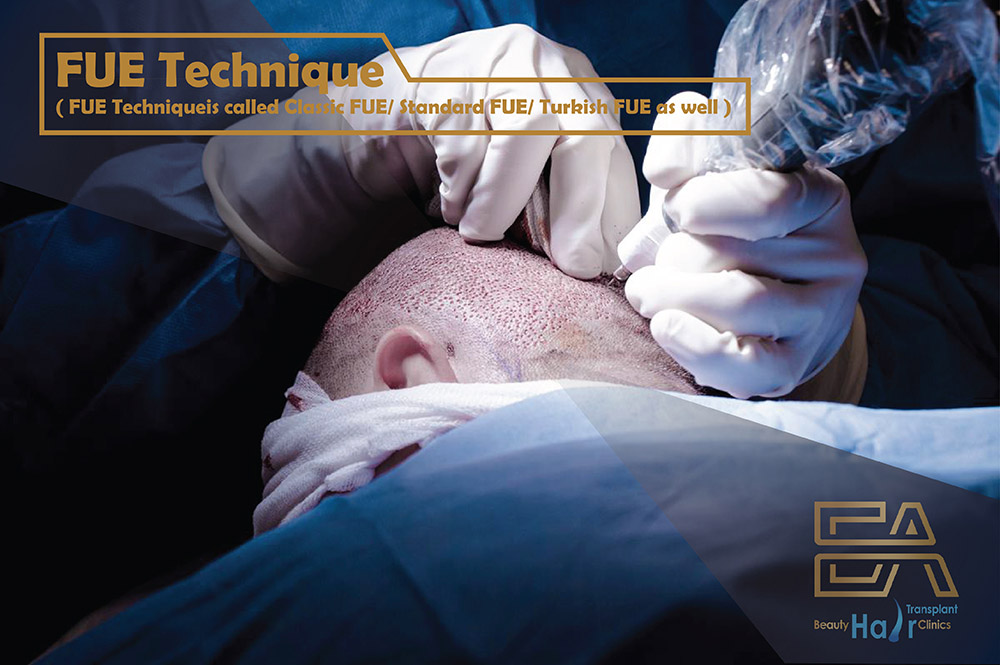
FUE Technique Benefits
Simpler and quicker,
Roots regenerate in 24 to 48 hours; there is no need for cutting or stitching; there is no loss of texture or feeling.
In addition to using grafts from the neck for the hair transplant, it can also be used for brow, mustache, and beard transplantation.
Faster healing time and lack of post-operative pain due to the little incision.
Punching FUE by hand or Manual
One of the FUE methods, Manual Punch FUE, involves doing hair transplants using a pen-shaped tool with a size range of 0.75 mm to 1.35 mm.
In a single FUE session using the manual punch technique, 2500 grafts can be harvested. An expert surgeon physically applies these harvested grafts to the scalp’s balding spot.
The following are some benefits of manual punch FUE:
Minimal scarring because to the pen-shaped instrument
Enables simple navigation around the follicular unit,
Graft harvesting can be done more quickly and without altering the grafts’ natural structure.
Due to its low Trans section rate, this approach is also regarded as the safest and most precise one.
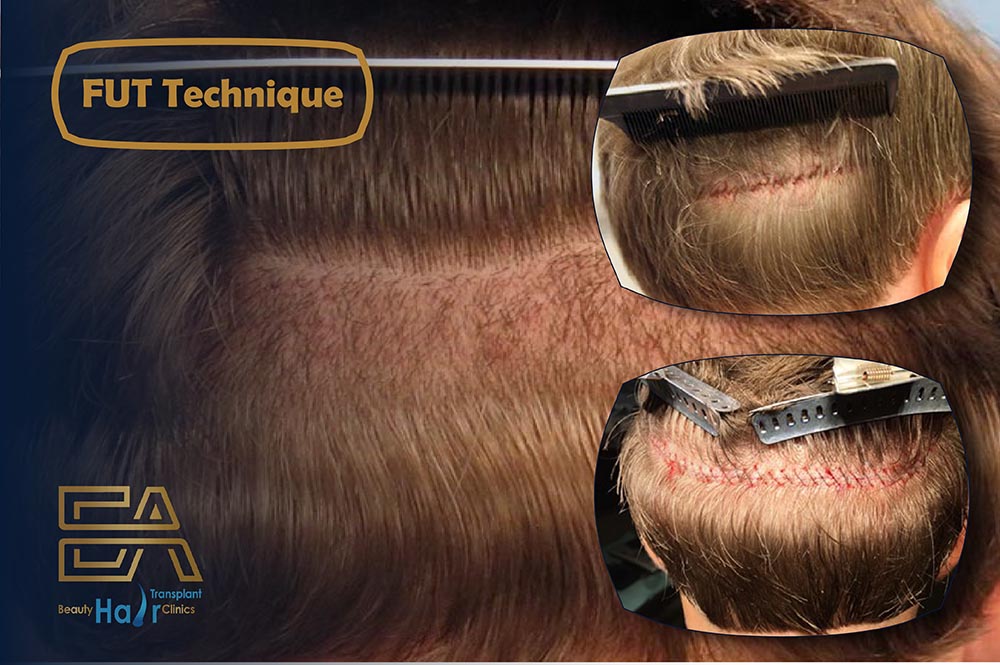
FUT Technique
In the procedure known as follicular unit transplantation, a long, thin strip of tissue from the donor area on the back and sides of the scalp is taken. Using a stereo microscope, the individual follicular units are then separated from the strip, and the incisions are then stitched shut, leaving a very fine, thin scar. The hair follicles are not harmed when the grafts are taken because a stereomicroscope is used. Because the microscopic channels do not disrupt the blood circulation, the hair grows faster as a result. A very small seam remains once the band’s cloth is finally fixed with sutures, but unless the hair is shaved short, no one can see it. We serve with this technique as well.
Advantages of FUT technique:
More hair follicles can be transplanted in a session,
Can be applicated or applied on eyebrow and beard transplantation,
To be done in a shorter period and less expensive,
No prominent/visible scar in patients with grey hair.
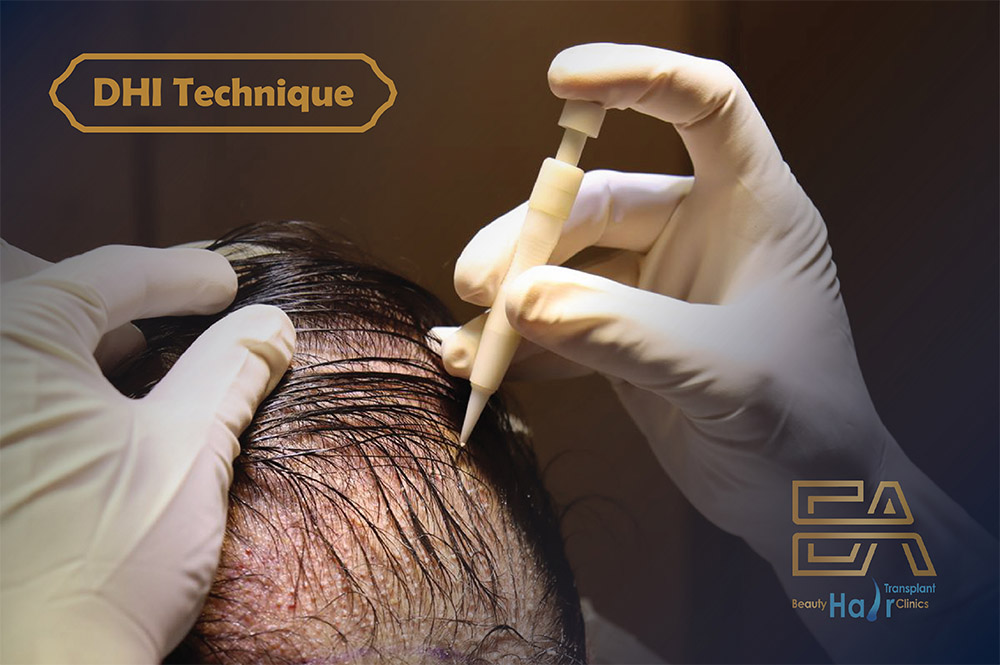
DHI Technique
Direct Hair Implantation is currently the most widely used procedure. Individually harvested grafts are planted in the planting regions using a specialized transplant instrument called the CHOI PEN, which ranges in thickness from 0.6 to 1 mm. In contrast to DHI, which does both the extraction and the implant at the same time, other procedures perform the process in two separate processes. The line must be drowned and the hair must be clipped to a specific length. Grafts are carefully collected without causing any damage. After defining the best angle and directions for transplantation, slits are made in the desired location for the implants. This method requires no cuts or holes, in contrast to the earlier ones, and therefore takes longer to complete. The cost is higher since many tools are used, and both the patient and the doctor need to be more cautious. We serve with this technique as well.
DHI Method Advantages
It is not necessary to shave the hair completely.
Quicker recovery.
Because grafts are extracted and placed directly, the hair is healthier.
Hair that is thick and luxuriant since additional root transplants may be necessary.
No scars still exist.
Graft angles can be determined more simply, therefore they are more reliable.
For those who have had severe hair loss, hair transplantation is the only option left. Various procedures are used, based on the patient’s requirements and preferences:
Follicular unit extraction (FUE), follicular unit transplant (FUT), and direct hair implantation (DHI) are three examples.
- Automated DHI
We will inform you about the DHI procedure (Direct Hair Implantation) in this article.
Let’s get going!
What Is the Direct Hair Implantation (DHI) Technique for Hair Transplantation?
The DHI (Direct Hair Implantation) procedure is one of the most cutting-edge approaches in the field of hair transplantation, and it offers the most benefits for those who desire to receive new hair. With this treatment, which allows for the implantation of 2500–3000 grafts, it is possible to have a new natural hair in as little as 5-7 hours.
With the DHI technique, hair transplantation is carried out without shaving and using a very small needle known as a Choi pen.
Describe Choi Pen.
A cylindrical tool called a Choi pen has an extremely small, sharp needle. Grafts are kept in place via the needle’s canal. The back of the head, which often includes healthy grafts, is used as the donor location during a hair transplant process. Each individual graft is implanted using a Choi pen without making an incision. Choi pens of a diameter of 0.5 to 1.5 mm can be used to implant hair organically.
Choi pens have various heads of various sizes for various hair kinds; depending on the patient’s requirements, 2–6 heads may be utilized during the procedure.
How Does the DHI (Direct Hair Implantation) Technique Work for Hair Transplantation?
DHI Hair Transplant has the following stages:
- The procedure is designed by creating a new hairstyle for the patient that fits their face.
- Each transplant is removed from the donor location separately.
The grafts are positioned in the Choi pen’s channels for direct implant, and Choi pen implants the grafts at the scalp at an angle of 40 to 45 degrees with the proper density based on the treatment plan and the patient’s features.
Why Direct Hair Implantation (DHI) Technique Is So Highly Recommended For Hair Restoration?
The DHI procedure is a modern, cutting-edge hair transplantation treatment with several benefits.
The following is a list of these benefits:
There aren’t any stitches or scars.
There are no incisions or stitches because the treatment is performed with a Choi pen, which uses extremely thin needles. So, there won’t be any scars.
Additionally, the danger of bleeding both during and after the procedure is reduced by not making an incision.
Hair does not need to be shaved.
The DHI approach has the wonderful benefit of not requiring complete hair removal prior to the surgery. In contrast to the other methods, you don’t need to shave any of your existing hair.
The grafts outside of the tissues last for a shorter period of time.
Compared to alternative methods,
The DHI approach has the wonderful benefit of not requiring complete hair removal prior to the surgery. In contrast to the other methods, you don’t need to shave any of your existing hair.
The grafts outside of the tissues last for a shorter period of time.
These grafts keep their validity for a longer period of time since they spend less time outside tissues when compared to other procedures. This is crucial for the grafts’ post-procedure tissue adaptation, which will result in a good outcome for you.
Transplantation of denser hair.
Compared to previous treatments, DHI technique enables denser hair transplantation. This method creates a natural-looking appearance. With the DHI procedure, thick hair can be achieved by implanting 120 grafts per square centimeter. Additionally, this method makes it very simple to create grafts and establish the growth angle.
An easy hair transplant
In addition to the benefits already described, DHI guarantees the patient a comfortable procedure. Due to the nature of the treatment, there is no incision made during the procedure, and local anaesthetic or anesthesia is used to numb the area only to a minimal degree. DHI is actually regarded as a painless hair transplant method.
However, because the DHI approach allows for the simultaneous completion of the grooving and root placement operations, successful hair follicle placement can be accomplished quickly.
Short period of recovery.
The healing time will be quicker than with other treatments because the DHI technique for hair transplantation involves no incisions or stitches.
Does the Direct Hair Implantation (DHI) method have drawbacks?
Patients wonder whether there are many drawbacks to the DHI approach before, during, and after administration.
Even while it can’t be considered a drawback, the DHI technique requires extremely careful execution by experts. In fact, the execution of this approach requires intense focus, which is crucial. We may add that trained personnel with expertise in this approach should carry out the procedures in order to get the best results.
Additionally, using the DHI technique for hair transplantation is more expensive than using alternative techniques. When compared to the patient’s needs, desires, and outcomes, the price difference can be considered as a minor element. It should be noted at this point that the choices made based solely on the transaction charge will not significantly benefit the patient in terms of results.





